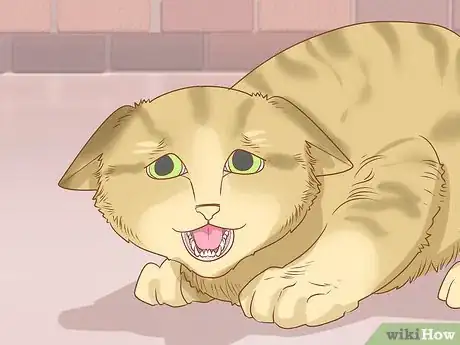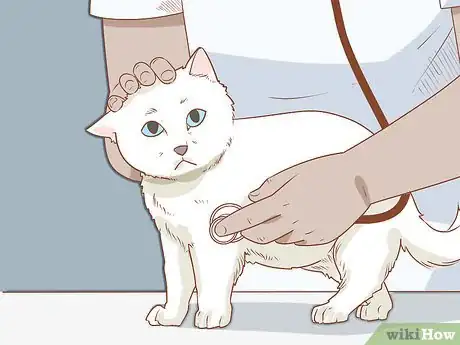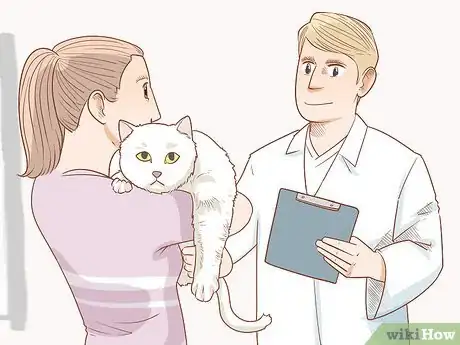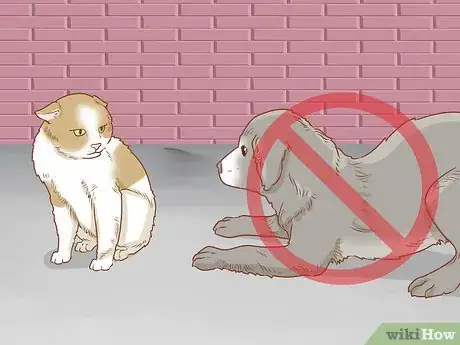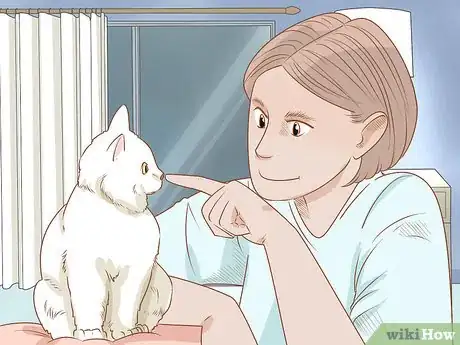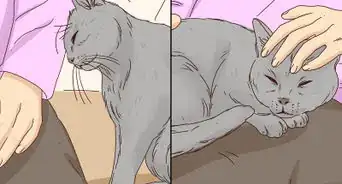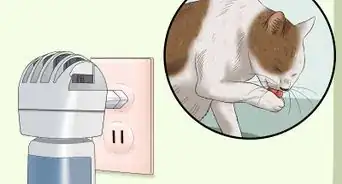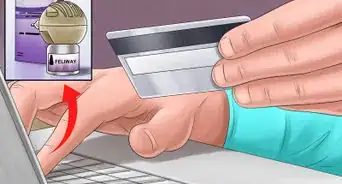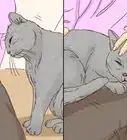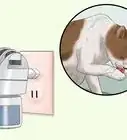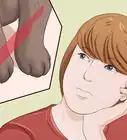This article was co-authored by Lauren Baker, DVM, PhD. Dr. Lauren Baker is a Veterinarian and Assistant Scientist at the University of Wisconsin-Madison. With over 10 years in veterinary medicine, she specializes in the concept of “one health,” which uses insights from veterinary medicine to help human medical research. She holds a Ph.D. in Comparative Biomedical Sciences, a Doctor of Veterinary Medicine, an MS in Comparative Biomedical Sciences, and a Bachelor’s degree in Psychology from the University of Wisconsin-Madison.
There are 7 references cited in this article, which can be found at the bottom of the page.
This article has been viewed 23,904 times.
Feline hyperesthesia is also called twitch-skin syndrome. It is a rare disorder in cats where the cat has episodes of frantic biting or licking of the back half of their body. No one knows why the disorder occurs, though it is believed to be an obsessive-compulsive disorder, seizure disorder, or type of neurological disorder. To diagnose the problem, identify the episodes in your cat and take them to the vet. Treating the problem includes creating a stress-free environment and giving the cat medication.
Steps
Recognizing Symptoms
-
1Monitor for episodes of abnormal movement. Symptoms of Feline Hyperesthesia occur in short episodes of abnormal behavior. The cat will be doing something normal, like sleeping, sitting, or walking, and then suddenly they will start moving in a repeated, twitching way. These episodes generally last from around 10 seconds to a few minutes. [1]
- After the episode is over, the cat will go back to the normal behavior they were doing before.
-
2Watch for self-harming behavior during an episode. During these episodes, the cat will engage in repetitive behavior that may result in self-harm. Their skin may start twitching, or the tail may swish back and forth in a violent, agitated manner. Because of this, they may start scratching or biting their skin, or they may start chasing their tail and trying to attack it.[2]
- The cat make start scratching their skin in an obsessive, repetitive way, or they will suddenly start licking or biting at their back, tail, or side. Often, this is combined with removing their fur and can be considered self-mutilating behavior.
- This often occurs after being touched by their owners.
Advertisement -
3Watch for other agitated behavioral changes. Your cat may exhibit other symptoms that make them seem frantic or agitated. They may suddenly open their eyes wide, and you may notice they have very dilated pupils. They may frantically run around the house after an episode.[3]
- The skin may start rippling on the back due to twitching muscles beneath it.
-
4Look for scared behavior. Some cats become extremely scared suddenly due to this condition. They may run away from something they think is a threat but that is not actually there. The cat may start salivating a lot or make agitated or frantic sounds.[4]
- Some cats may have accidents where they suddenly urinate.
Diagnosing FHS
-
1Take your cat to the vet. This condition is diagnosed by ruling out other diseases. The vet also assesses the symptoms to help identify the condition. The vet will do a physical exam to check for symptoms of other diseases.[5]
- Videos of your cat’s episodes may help the vet determine if the symptoms are FHS.
-
2Get tests to rule out other conditions. There is no specific test for FHS. Instead, the vet needs to test for other conditions to rule those out before diagnosing hyperesthesia. The vet will perform blood work to check blood count, the thyroid, and the blood chemistry. They will also do skin tests to check for parasites, skin allergies, or dermatitis.[6]
- The vet may also do imaging tests to check for internal problems.
-
3Take the cat to a specialist. In some cases, the vet will refer the cat to a specialist. These specialists will do more specific tests to rule out rare diseases and more definitively diagnose FHS. Neurologists and dermatologists are usually consulted in these cases since FHS deals with both the brain and the skin.[7]
Treating Hyperesthesia
-
1Give your cat medication. The vet may prescribe medication to help manage your cat’s symptoms. The cat may be given antidepressants, anti-obsessional, or anti-convulsant medications. These drugs aim at calming the cat and reducing anxiety.[8]
-
2Reduce stressors for your cat. The symptoms of this condition often occur when the cat is overly stressed. Reducing as much stress for your cat can help. Things that stress your cat may not make sense to you, like being fed at a different time.[9]
- Try feeding your cat on a schedule. Routine can help ease stress for the cat.
- Aggression between other pets and people in the house can cause stress to the cat. Address this aggression to help give all pets a calmer environment.
- Provide your cat with appropriate vertical space, such as a cat tree, and areas to hide.
-
3Interact with your cat. Not getting enough time with you may cause stress. Play with them with toys, have them run around and chase small balls of paper or toys, and provide cat furniture. Cat furniture can also help them jump and run to expel energy.
- Exercise and spending time with you helps decrease the cat’s boredom, which can reduce their stress.
-
4Avoid stimulating the cat’s skin. Taking care to not bother the cat’s skin can help. Avoid scratching the cat, especially on their back. You should also be careful not to touch along their tail and the bottom half of their body. Those areas are extremely sensitive and may trigger an episode.[10]
References
- ↑ http://www.petmd.com/cat/conditions/skin/c_ct_feline_hyperesthesia_syndrome
- ↑ https://www.vetinfo.com/feline-hyperesthesia-syndrome.html
- ↑ https://www.vetinfo.com/feline-hyperesthesia-syndrome.html
- ↑ http://www.vet.cornell.edu/fhc/Health_Information/HyperesthesiaSyndrome.cfm
- ↑ http://www.cathealth.com/skin/hyperesthesia
- ↑ https://www.vetinfo.com/feline-hyperesthesia-syndrome-treatment.html
- ↑ http://www.cathealth.com/skin/hyperesthesia
- ↑ https://www.vetinfo.com/feline-hyperesthesia-syndrome-treatment.html
- ↑ https://www.vetinfo.com/feline-hyperesthesia-syndrome-treatment.html
About This Article
To diagnose and treat hyperesthesia syndrome in your cat, watch for short episodes of abnormal behavior. During these brief episodes, note if your cat starts twitching, scratching obsessively, biting its skin, or running frantically around the house, which are common symptoms of hyperesthesia. If you are concerned that your cat may be suffering from hyperesthesia, take it to the vet, who will perform an exam and order blood work to rule out other diseases. Once your cat is diagnosed with hyperesthesia, it may be placed on medication to help manage its symptoms. In addition to these medications, reduce your cat’s stress level, which can trigger the symptoms, by feeding it on a regular schedule, giving it plenty of areas to climb and hide, and providing it with extra affection. For more tips from our Veterinary co-author, including how to find a specialist to treat your cat’s hyperesthesia, keep reading!



